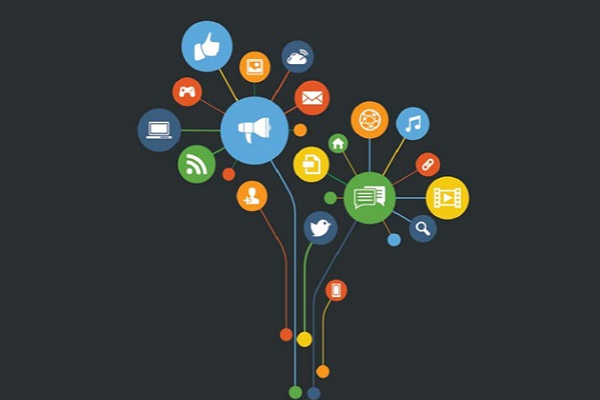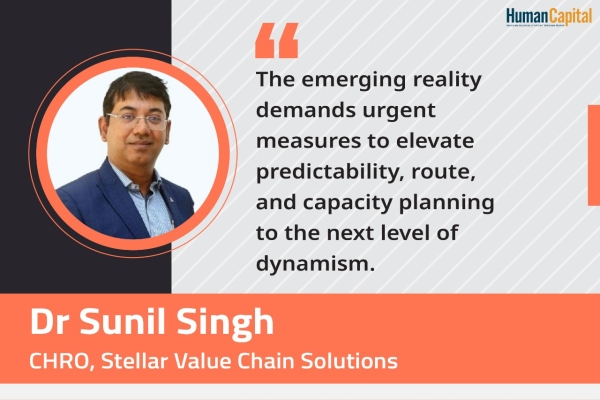Social media has emerged as a very powerful tool that can be engaged by every business with its workforce, its customers, and other stakeholders as appropriate to connect, empower, evolve, and benefit.
While it may not be the panacea, Social Media is certainly a surefire, unmissable tool in the HR's arsenal, particularly in the time-space of technology disruption and workforce transformation. Cloud and smart phone proliferation due to increased affordability, deeper internet penetration, and user-friendly technology in the form of messenger apps and social media have cumulatively been instrumental for the democratisation of media on all fronts - text, picture, audio, and video. Now-a-days, anybody with a smartphone and internet access can consume and also author/publish digital content with ease. Evidently, such empowerment in the hands of every user without proper accountability, control, and governance could lead to chaos.
According to the 'Global State of Digital in 2019 Report' published by 'Hootsuite' and 'We are Social', out of the Indian population of 1.361 billion: -
◆ 87% are unique mobile users
◆ 41% are internet users
◆ 23% active social media users
◆ 21% are mobile social media users And only 32% of the internet users use social media for work purposes, leaving a huge potential for further adoption and opportunity for growth at workplace.
Of all the internet users in India: -
◆ 89% use mobile messengers
◆ 91% watch videos on mobile
◆ 75% play games on mobile
◆ 57% use mobile banking
◆ 82% use mobile map services
While the Indian population is growing at 1.1% YoY, unique mobile users have been growing at 2.8%, internet users at 21%, social media users at 24%, and mobile social media users at a whopping 26%.
An average Indian daily spends: -
◆ 7h47m on the internet
◆ 2h32m on social media
◆ 2h51m on Television
◆ 1h29m listening to streaming music For the Southern Asia region, the internet penetration is 42%, mobile connectivity is 91%, and Social media penetration is at 24%.
From the perspective of highest active user accounts, the top social platforms are Facebook, YouTube, WhatsApp, Facebook messenger, WeChat, Instagram, Tiktok, Twitter, LinkedIn, Skype, Snapchat, Viber, etc. It is important to note that 3 of the top 5 platforms today are messenger/VoIP platforms.
While Facebook messenger is the top social messenger in US and Australia, WhatsApp is the top social messenger in India, Europe, Russia, Africa and the rest of the world (other than US and Australia). Users in the corporate domain use social media to connect and communicate with their friends, peers, or organizational teams (internal and external). It is also used by them to learn and upskill themselves with the content available in the public domain or by their employer for their enablement and development. The reach and frequency of social media and the pervasive engagement across the workforce, presents an unprecedented and a great opportunity to leverage each member of the workforce and ecosystem of stakeholders as brand builders, trusted influencers, and an incredible source of referrals to manage perceptions, and build the company brand internally as well as externally.
While the messenger/Voice over IP(VoIP) platforms enable private communications between individuals and groups/teams, the other social media platforms make the published content even more public than what was originally intended by the author. Today, information travels in a flash and reaches millions of people in a jiffy. It is both an opportunity and a challenge to manage and ensure such communication is well aligned to the overall business strategy, and is coherent with the other forms of content and communication made available on the said topic. It is important to manage the expectations of the audience in terms of the response time for their queries.
Here are few examples where such simple communications may have some serious unintended consequences. When a travelling salesman or an interviewing candidate blogs on his/her Facebook about his recent experience interacting with a customer, and is venting out his/her frustrations, they seem to disregard the fact that it is also being seen by the other party or someone in their own network, leading to some unpleasant outcomes. Similar is the case with information leaks via blogs on product launches, leadership changes, business announcements, etc. While one may assume that the information has been shared informally with their friends, it may quickly go out of hand when such a thing is further shared inadvertently across a wider audience, compromising the very objectives of the company.
Drawing the line
Therefore, it becomes critical to create a distinction between the communications sent out by the official team on behalf of the company as against individual opinions expressed by employees or other stakeholders. It behooves every organisation to come forward with a disclaimer to call out such a distinction, and hold employees responsible for their communication.
Again, employees must be provided with appropriate platforms to voice their opinions to avert the possibilities of them hauling their dirty laundry in public. Employees must be sensitised, trained, and encouraged to publish on social media with accountability, and make them refrain from posting irresponsible posts that could hold either the employee, the employer, or both in a bad light. The damage caused due to such irresponsible posts could be severe, and at times, irrecoverable. HR can help employees to become mindful with their posts, and not blurt out their emotions on social media on an impulse.
Bad reputation of any company could lead to losing customers, revenue, investors, and employees. The National Labor Relations Board (NLRB) in the United States has stated that workers have the right to discuss work conditions liberally, openly, and with no fear of retaliation, whether the discussion is done at the office or on social media. Labour regulators have acknowledged that many such blanket restrictions by employers are illegal. Many view social media as the new water cooler, in which the federal government provides complete protection to employees to express their right. In other words, this could lead to defamation by publishing something untrue about someone and could harm their reputation and put them in trouble. To avoid surprises, the business must carefully monitor and track all that is being said and talked about the company on social media to position itself to be viewed neutrally, if not positively, at all times. This might require some proactive evangelical messaging, agile and timely counter messaging to avoid spreading false rumours or misperceptions, and to quickly gain control.
Also, it is essential to clarify about the consequences if/when such a policy is violated. Companies should have a social media policy in place to communicate to employees what should be possibly said, and what could potentially cost them their jobs. Utilisation of social media tools in the organisation while creating a ton of opportunities can also present certain challenges for HR professionals.
Social media could benefit an organisation in many areas. However, if not utilised effectively, it can create mutiple risks on the legal, financial, and also on the personnel fronts. Given the potential risks and benefits of using social media in the workplace, it is crucial for HR managers to develop policies and procedures governing its appropriate use. The onus lies with HR to architect the Internet policy in conjunction with the IT department and create a free yet well monitored, safe, and secure environment for its employees to engage and participate. Also, it is prudent to create and enforce a PR/Communications policy to guide the employees on the Do's and Don'ts of online communications so that the employees are sensitised on what could potentially hurt the image, brand, and valuation of the company even when it is done inadvertently.
HR professionals may face the challenge of discrimination if they fail to use the information obtained from social media in good spirit and health. For instance, obtaining personal information about ethnicity and then rejecting the applicant in the hiring phase could land a company in trouble. Given that the information published on social media will be accessed by different people from different geographies instantly, one has to ensure that the information so published is region agnostic and in sync with whatever is being published separately on local channels. For instance, information which is region sensitive, such as holidays, benefits, local regulation, pricing, or promotions will have to be segregated and published based on targeted IPs.
Leveraging social media
HR has been able to find effective ways to leverage social media in talent acquisition to post open jobs both internally and externally, collect background information, and carry out reference checks of prospective hires. Since few people manipulate their profile information to manage the personal image amongst their friends and targeted audience, it is advisable to collect such personal data prior to the interviews so that it can be verified and validated through the interviewing process. When engaging social media, it is important to ensure a good mix of diverse platforms that target relevant audience so that the business does not miss out on tapping into certain talent pools due to the coverage of social media platforms or lack thereof.
Since the current demographic spends a good amount of their active day (almost 8 hours) online and about one-third of that on social media, it is prudent for HR to leverage that channel to engage with the workforce with relevant, high quality, and bite-size content to gain high recall value and mindshare of its employees, as opposed to worrying about possible loss of productivity due to such distraction at workplace. L&D teams have been leveraging social media platforms to deploy short clips of video or podcasts to enable and develop their employees. Such content is not only quickly consumable on the run by the users, but is available anywhere and at any time as per their convenience.
Social media platforms are often engaged to collect employee opinions and feedback on strategic priorities and key initiatives. Once the business generates a wealth of such data that constitutes the voice of their employees, it can conduct predictive analytics to avoid unpleasant surprises for future reforms. This has also proven to be helpful in building the employee morale, which in turn boosts employee retention and productivity gains. Undoubtedly, Social media has emerged as a very powerful tool that can be engaged by every business with its workforce, its customers and other stakeholders as appropriate to connect, empower, evolve, and benefit.

Has COVID-19 forever changed the way we live and work?
Trending
-
SBI General Insurance Launches Digital Health Campaign
-
CredR Rolls Out 'Life Happens' Leave For Its Employees
-
Meesho Announces 30-Week Gender-Neutral Parental Leave Policy
-
Microsoft Unveils Tech Resilience Curriculum To Foster An Inclusive Future
-
60% Indian Professionals Looking For Job Change Due To COVID: Survey
-
SpringPeople And Siemens Collaborate For Digital Transformation Push
-
86% Professionals Believe Hybrid Work Is Essential For Work Life Balance: Report
-
Almost 1 In Every 3 People's Personal Life Affected Due To Work Stress
-
Meesho Rolls Out Reset And Recharge Policy For Employees
-
80% Of Talent Leaders & Academics Say Pandemic Changed Skill Needs For Youth: Report
-
Hero Electric Rolls Out 'Hero Care' Program For Employees
-
Human Capital In Collaboration With ASSOCHAM Hosts Virtual Conference
-
IKEA India, Tata STRIVE Collaborate To Create Employability And Entrepreneurship Opportunities
-
SAP India, Microsoft Launch Tech Skilling Program for Young Women
-
DXC Technology, NASSCOM Collaborate For Employability Skills Program
-
Lenskart To Hire Over 2000 Employees Across India By 2022
-
Mindtree Launches Learn-and-Earn Program
-
Tata AIA Extends 'Raksha Ka Teeka' To Its Employees
-
Swadesh Behera Is The New CPO Of Titan
-
NetConnect Global Plans To Recruit 5000 Tech Professionals In India
-
Hubhopper Plans To Hire 60% Of Indian Podcasters By 2022
-
Corporate India Needs More Women In Leadership Roles: Report
-
Aon to Invest $30 Million and Create 10,000 Apprenticeships by 2030
-
Tech Mahindra Launches ‘Gift a Career’ Initiative for Upskilling of Youth
-
40% Women Prefer Flexible Working Options in Post-COVID World: Survey
-
3 out of 4 companies believe they can effectively hire employees virtually: Report
-
Vodafone , CGI and NASSCOM Foundation launch digital skills platform
-
Odisha: Bank, postal employees to deliver cash for elderly, differently-abled persons
-
Skill India launches AI-based digital platform for "Skilled Workforce"
-
Hiring activity declines 6.73% in first quarter: Survey
-
70% startups impacted by COVID-19 pandemic
-
Bajaj Allianz Life ropes in Santanu Banerjee as CHRO
-
Over 70 Percent MSMEs look at cutting jobs to sustain businesses
-
93 Per Cent employees stressed about returning to office post-lockdown
-
Johnson & Johnson India announces family benefits for same gender partners
-
Indian firms turning friendly towards working mothers
-
Welspun India names Rajendra Mehta as new CHRO
-
Wipro partners with NASSCOM to launch Future Skills platform



Human Capital is niche media organisation for HR and Corporate. Our aim is to create an outstanding user experience for all our clients, readers, employers and employees through inspiring, industry-leading content pieces in the form of case studies, analysis, expert reports, authored articles and blogs. We cover topics such as talent acquisition, learning and development, diversity and inclusion, leadership, compensation, recruitment and many more.
Subscribe Now












































Comment